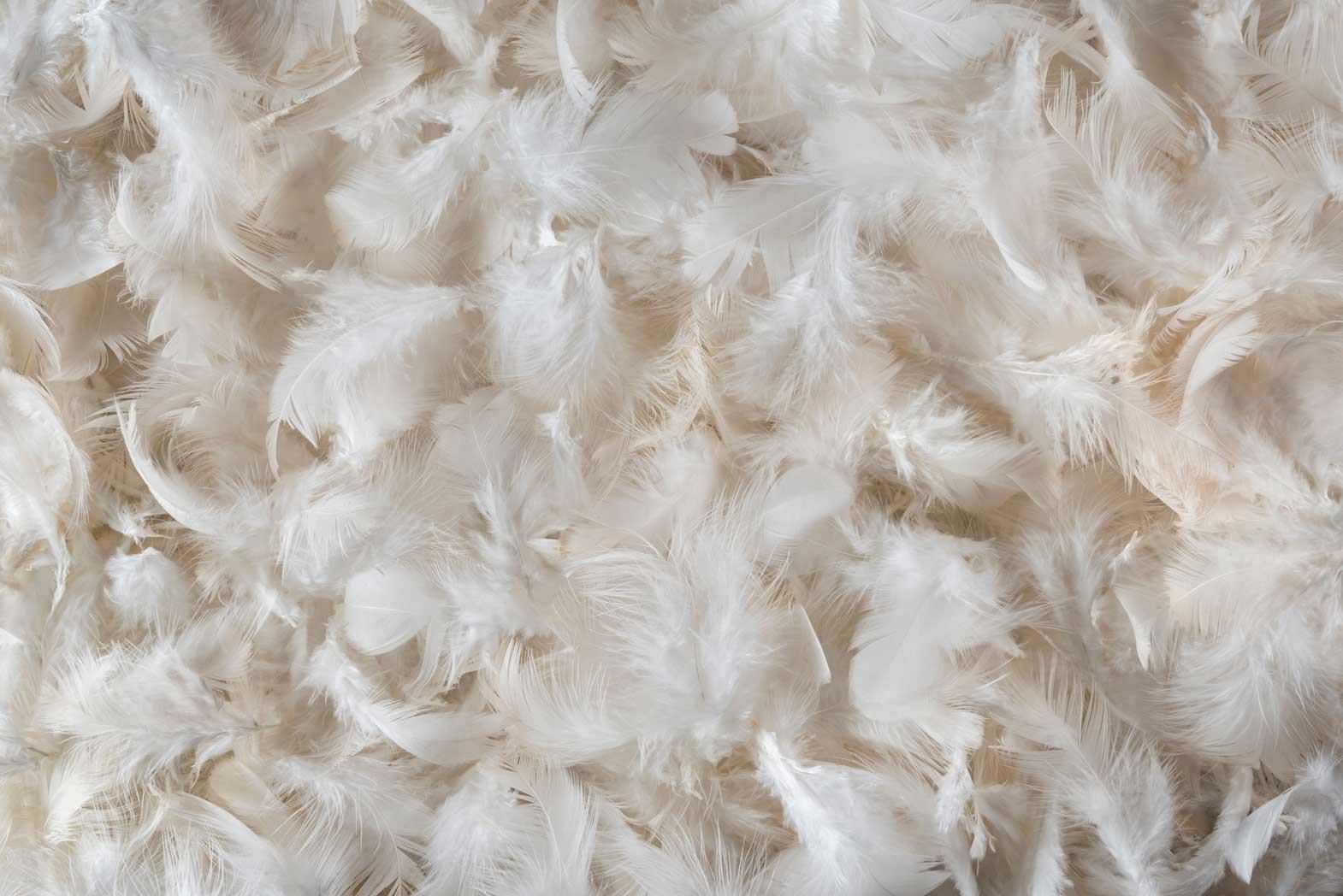The utilisation of chicken feathers as a sustainable resource for textile production has gained significant attention in recent years. With the growing concerns over environmental sustainability and the need to reduce waste, exploring alternative materials for textiles has become imperative. Chicken feathers, abundant byproduct of the poultry industry, possess unique properties that make them suitable for various textile applications. Every year, the poultry business produces six billion tonnes of chicken feathers, the majority of which end up in landfills. Chicken feathers have recently found their way into everything from art projects to running shoes to automotive manufacture.
Chicken feather fibres are found to possess high toughness, good thermal insulation and acoustic properties, nonabrasive behaviour, more hydrophilic and less hydrophobic in nature. Chicken feathers are a great option for the textile industry because they are plentiful, their supply is certain, and their quality is constant.
Applications
Chicken feathers could be used in future garments to create textiles like cotton, linen, or wool, reducing the need for synthetic materials like polyester. The feathers are washed, dried, ground, and dissolved. Agricultural proteins like keratin from chicken feathers offer fabric potential. Chemical cross-linking and nanotechnology can enhance their tensile strength and biodegradability, enabling mass production of eco-friendly products. They have a robust honeycomb construction with small air pockets, making them incredibly lightweight and durable. Their barbs and barbules provide a comparable sensation to wool on the skin.
I. Garments Made of Chicken Feather Fibre
Down Jackets: Chicken feather fibres, particularly the soft and fluffy under feathers known as ‘down’, are often used as insulation in winter jackets and coats. Down provides excellent warmth-to-weight ratio, making jackets lightweight and highly insulating. Down feathers are prized for their softness, making them suitable for use in the lining of coats, jackets, and even in hoods to provide a luxurious feel.
Vests: Down vests are another popular garment that uses chicken feather fibres for insulation. They are ideal for layering and provide warmth without bulk.
Sleeping Bags: Chicken feather fibres are commonly used in the insulation of sleeping bags, ensuring a warm and comfortable sleep experience, especially in cold weather conditions.
Outdoor Apparel: Chicken feather fibres are used in various outdoor clothing items, including gloves, mittens, and boots, to provide insulation and keep users warm during outdoor activities. Chicken feather fibres can be found in inner linings and padding of various winter garments to provide extra warmth and comfort.
II. Pillows:
Feather Pillows: Chicken feather fibres, specifically down and feather blends, are commonly used as filling material in pillows. Feather pillows are known for their softness, support, and ability to conform to the shape of the user’s head and neck.
Pillow Inserts: Feather and down pillow inserts are used to fill decorative pillow covers, providing a plush and luxurious look to the pillows.
Body Pillows: Long body pillows filled with chicken feather fibres offer excellent support and comfort for individuals who prefer a larger, snuggly pillow.
Adjustable Pillows: Some pillows are designed with compartments or chambers filled with chicken feather fibres, allowing users to adjust the loft and firmness of the pillow to their preference.
To address concerns about allergies, some manufacturers offer hypoallergenic versions of feather and down pillows, where the feathers are carefully cleaned and sanitised to minimise allergens. It is also important to note that the quality of chicken feather fibre-based products can vary based on factors such as the type of feathers used, the processing methods, and the ratio of feathers to down. Additionally, proper care and maintenance, such as regular fluffing and occasional drying, can help extend the lifespan of garments and pillows filled with chicken feather fibres.
III. Diapers
While chicken feather fibres are not a conventional or widely used material in diaper production, they have unique properties that, in theory, could make them suitable for certain diaper applications. Here are some potential ways chicken feather fibres could be used in diapers:
Absorbent Core: Chicken feather fibres can be processed and treated to improve their absorbent properties. They could be incorporated into the absorbent core of a diaper along with other materials like superabsorbent polymers (SAP) and cellulose fibres to enhance the diaper’s overall absorbency.
Biodegradable Back sheets: Chicken feather fibres could be used in the construction of the diaper’s outer back sheet. This could make the back sheet more environmentally friendly and biodegradable compared to traditional plastic backings.
Breathability: Feather fibres have natural breathability, which could be beneficial for diaper designs aimed at maintaining airflow and reducing moisture build-up, thus potentially reducing diaper rash.
Sustainable Diapers: Incorporating chicken feather fibres into diaper production could contribute to sustainability efforts by utilising a byproduct of the poultry industry and reducing waste.
However, research and development would be necessary to explore the feasibility of using chicken feather fibres in diapers and to address regulation requirement challenges.
IV. Chicken Feather Nonwoven Sheets
Chicken feather nonwoven sheets, which can be made from processed and treated chicken feather fibres, have various potential applications due to their unique properties. These sheets can be used in a range of industries for diverse purposes.
Soil Erosion Control: Chicken feather nonwoven sheets can be used as erosion control blankets in landscaping and agriculture to stabilise soil and prevent erosion on slopes and construction sites.
Construction and Civil Engineering: Chicken feather nonwoven sheets, given their natural insulation properties, can be used as an insulating material in construction for applications such as wall insulation or soundproofing.
Automotive Interiors: These sheets can be used for sound and thermal insulation within vehicles to reduce noise and improve temperature control.
Air and Liquid Filtration: Chicken feather nonwoven sheets can be used as filter media in various applications, including air filtration in HVAC systems and liquid filtration in industrial processes.
Packaging: These sheets can be used as cushioning material in packaging to protect fragile items during shipping and transportation.
Biodegradable Mulch: Chicken feather nonwoven sheets can serve as biodegradable mulch for agricultural fields, helping to retain moisture, suppress weeds, and improve soil health.
Fashion Accessories: Designers explore the use of chicken feather nonwoven sheets to create unique fashion accessories like hats, fascinators, and jewellery.
Art and Craft: Chicken feather nonwoven sheets can be used in art and craft projects for their unique texture and appearance.
V. Chicken Feathers in Technical Textiles
Chicken feather fibres can be processed and incorporated into insulation materials used in construction, automotive, and aerospace applications. Their natural insulation properties make them effective at maintaining temperature control.
Filtration Media: Chicken feather fibres can be used as filter media in applications such as air and liquid filtration. Their fine fibres and porous structure can capture particles and contaminants.
Geotextiles: Chicken feather nonwoven sheets can be used as geotextiles in civil engineering and construction projects. They can provide erosion control, soil stabilisation, and drainage solutions.
Sound Absorption: Chicken feather fibres can be used in sound-absorbing materials for acoustic control in buildings, automobiles, and industrial environments.
Biodegradable Textiles: Technical textiles made from chicken feather fibres can be designed to be fully biodegradable, making them suitable for applications where sustainability and minimal environmental impact are important.
Reinforcement in Composites: Chicken feather fibres can be incorporated into composite materials to enhance their strength and reduce weight. These composites can find use in industries like automotive, aerospace, and sports equipment manufacturing.
Flame Retardant Materials: Chicken feather fibres can be treated to improve their flame-resistant properties. This can be valuable in applications where fire safety is a concern.
Oil Spill Cleanup: Nonwoven materials made from chicken feather fibres can be used in oil spill cleanup efforts due to their ability to absorb and contain hydrophobic substances like oil.
Protective Apparel: Technical textiles made from chicken feather fibres can be used in the development of protective clothing and gear for industries like firefighting, chemical handling, and hazardous waste management.
Aerospace Applications: Chicken feather fibres can be used in aerospace applications, such as lightweight materials for aircraft interiors, insulation for spacecraft, or even as reinforcement in advanced composites.
Conclusion
Chicken feather fractions have potential applications as textile fibres for yarns, fabrics, and composites. The poultry sector generates significant profits globally but also produces considerable waste, including chicken feathers. With ongoing research and innovation, chicken feathers may soon transition from coops to cups, potentially reducing the need for new plastic production on a large scale. Researchers are exploring new ways to leverage the unique properties of chicken feather fibres in various technical textile applications.


 (1)20240730094415.jpg)







Comments